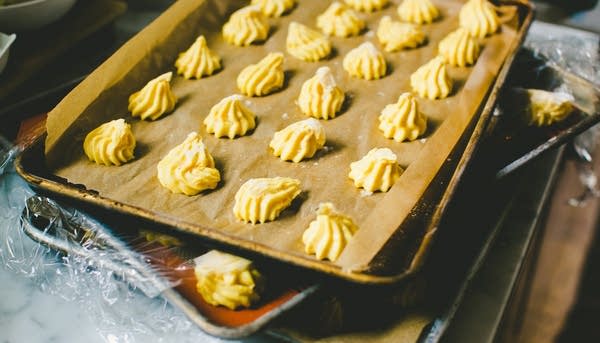
Let me walk you through the experience of eating a fresh gougère. It's surprisingly light as you pick it up, almost insubstantial and still hot from the oven. The crispy shell crunches as you pull it open, releasing a puff of savory steam. Then you hit the middle: soft, eggy, and indecently cheesy. Two bites and it's gone. You're going to want to make a batch of these soon, trust me.
Gougères are based on the classic French pâte à choux, which was the first pastry we were taught to make in culinary school. Believe me, if newbie culinary students still scared of whisks can make this dough, so can you.
The recipe is very straight forward. No tricks or potential snags here! It's important to cook the dough for a few minutes before adding the eggs; this dries it out and makes it more able to absorb the eggs. Adding the eggs in four additions also helps work them into the dough more easily and evenly. The two different baking temperatures help the gougères to first puff and then dry into crispy globes.
I have yet to make gougères for a dinner party and not be met with gasps of delight as I emerge from the kitchen with the still-steaming tray. I love serving them as an alternative to dinner rolls, but they are also light enough to be an appetizer without ruining people's appetite. For potlucks or picnics, I've also stuffed the gougères with deli meat and a few greens to make quick, bite-sized sandwiches.
Anyway you do it, you can't go wrong. Scout's honor.
What You Need
Ingredients
1 cup (8 ounces) water
8 tablespoons (4 ounces/1 stick) unsalted butter, cut into several pieces
1/2 teaspoon salt
1/2 teaspoon dry mustard powder (optional)
1 cup (5 ounces) all-purpose flour
4 large eggs, lightly beaten
1 1/2 cup (6 ounces) grated cheese, like gruyère or cheddar
Equipment
2- to 4-quart saucepan
Long-handled spoon
Standing mixer (optional)
Baking sheets
Instructions
1. Boil the Water and Butter: Combine the water, butter, salt, and mustard (if using) in a 2- to 4-quart saucepan and bring to a rolling boil.
2. Add the Flour: Once all the butter has melted, remove the pan from heat and add the flour all at once. Stir vigorously until the mixture comes together and resembles mashed potatoes.
3. Cook the Dough: Return the pan to medium-low heat and stir for 3-5 minutes to dry out the dough. The dough is ready when it glistens and is thick enough to hold a spoon upright. Some starch buildup on the bottom of the pan is normal.
4. Add the Eggs: Transfer the dough to the bowl of a stand mixer fitted with a paddle attachment. (The following steps can also be done with a hand mixer or by hand with a stiff spatula.) Beat the dough on a medium-low speed for one minute until it stops steaming and is just warm to the touch.
Continue beating and add the egg in four additions. Wait for each addition to be absorbed and for the dough to smooth out before adding the next. Scrape down the sides of the bowl if needed between additions. In the end, the dough should come together in a very smooth, creamy batter. Beat in the cheese.
5. Bake the Gougères: Heat the oven to 450°F. Scoop rounded tablespoons of dough onto sheet pans lined with silicone mats or parchment paper. Space them at least an inch apart.
 Photo: Rachel Joy Baransi for The Kitchn
Photo: Rachel Joy Baransi for The Kitchn
Bake the gougères for 5 minutes and then turn the heat down to 350°F. Bake for another 20-25 minutes, rotating the pans once during baking. The finished gougères will be puffed, deep golden-brown, and dry to the touch (the cheese may still be bubbling a bit). They will also feel light and hollow when picked up.
6. Cool the Gougères: Transfer the sheet pan to a cooling rack. Serve warm or room temperature. Leftovers can be stored in the refrigerator and re-crisped in a warm oven before serving or frozen for up to three months.
Additional Notes
Freeze for Later: To have gougères on hand for later, try freezing them shaped but un-baked. Scoop and then freeze them directly on the baking sheet. Once frozen, you can transfer them to a freezer storage container. Bake them directly from the freezer while still frozen, and let them bake for the longer end of the time range.
Bigger or Smaller Gougères: Make the gougères any size that appeals to you. Teaspoon scoops are a fun party snack or soup topper while double-sized gougères are nice for making sandwiches or as part of a brunch spread.
Before you go...
Each week, The Splendid Table brings you stories that expand your world view, inspire you to try something new, and show how food connects us all. We rely on your generous support. For as little as $5 a month, you can have a lasting impact on The Splendid Table. And, when you donate, you’ll join a community of like-minded individuals who love good food, good conversation, and kitchen companionship. Show your love for The Splendid Table with a gift today.
Thank you for your support.
Donate today for as little as $5.00 a month. Your gift only takes a few minutes and has a lasting impact on The Splendid Table and you'll be welcomed into The Splendid Table Co-op.



